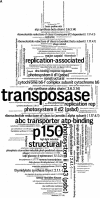Transposases are the most abundant, most ubiquitous genes in nature
- PMID: 20215432
- PMCID: PMC2910039
- DOI: 10.1093/nar/gkq140
Transposases are the most abundant, most ubiquitous genes in nature
Abstract
Genes, like organisms, struggle for existence, and the most successful genes persist and widely disseminate in nature. The unbiased determination of the most successful genes requires access to sequence data from a wide range of phylogenetic taxa and ecosystems, which has finally become achievable thanks to the deluge of genomic and metagenomic sequences. Here, we analyzed 10 million protein-encoding genes and gene tags in sequenced bacterial, archaeal, eukaryotic and viral genomes and metagenomes, and our analysis demonstrates that genes encoding transposases are the most prevalent genes in nature. The finding that these genes, classically considered as selfish genes, outnumber essential or housekeeping genes suggests that they offer selective advantage to the genomes and ecosystems they inhabit, a hypothesis in agreement with an emerging body of literature. Their mobile nature not only promotes dissemination of transposable elements within and between genomes but also leads to mutations and rearrangements that can accelerate biological diversification and--consequently--evolution. By securing their own replication and dissemination, transposases guarantee to thrive so long as nucleic acid-based life forms exist.
Figures




References
-
- Huxley JS. Evolution: The Modern Synthesis. 1st edn. London: Harper; 1942.
-
- Dawkins R. The Selfish Gene. Oxford: Oxford University Press; 1976.
-
- Edgell DR, Fast NM, Doolittle WF. Selfish DNA: the best defense is a good offense. Curr. Biol. 1996;6:385–388. - PubMed
-
- Doolittle WF, Sapienza C. Selfish genes, the phenotype paradigm and genome evolution. Nature. 1980;284:601–603. - PubMed

